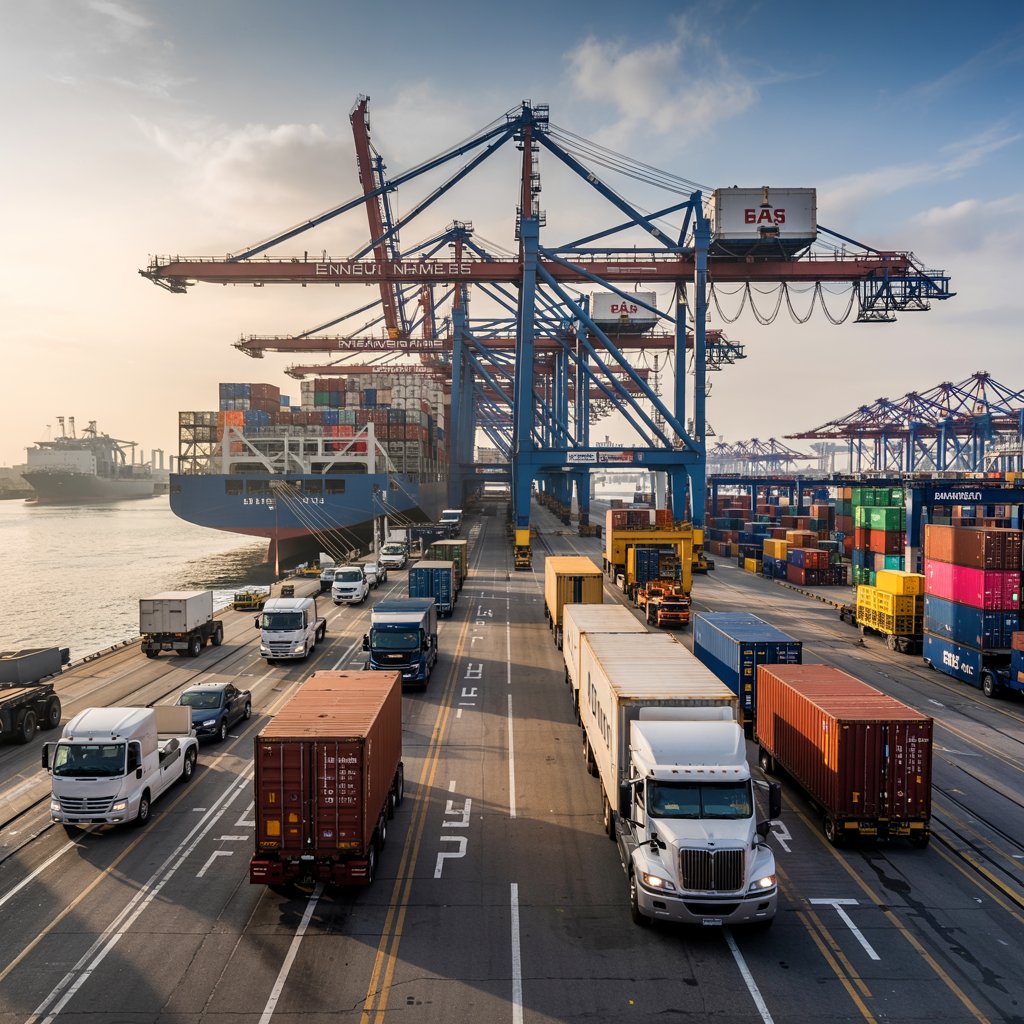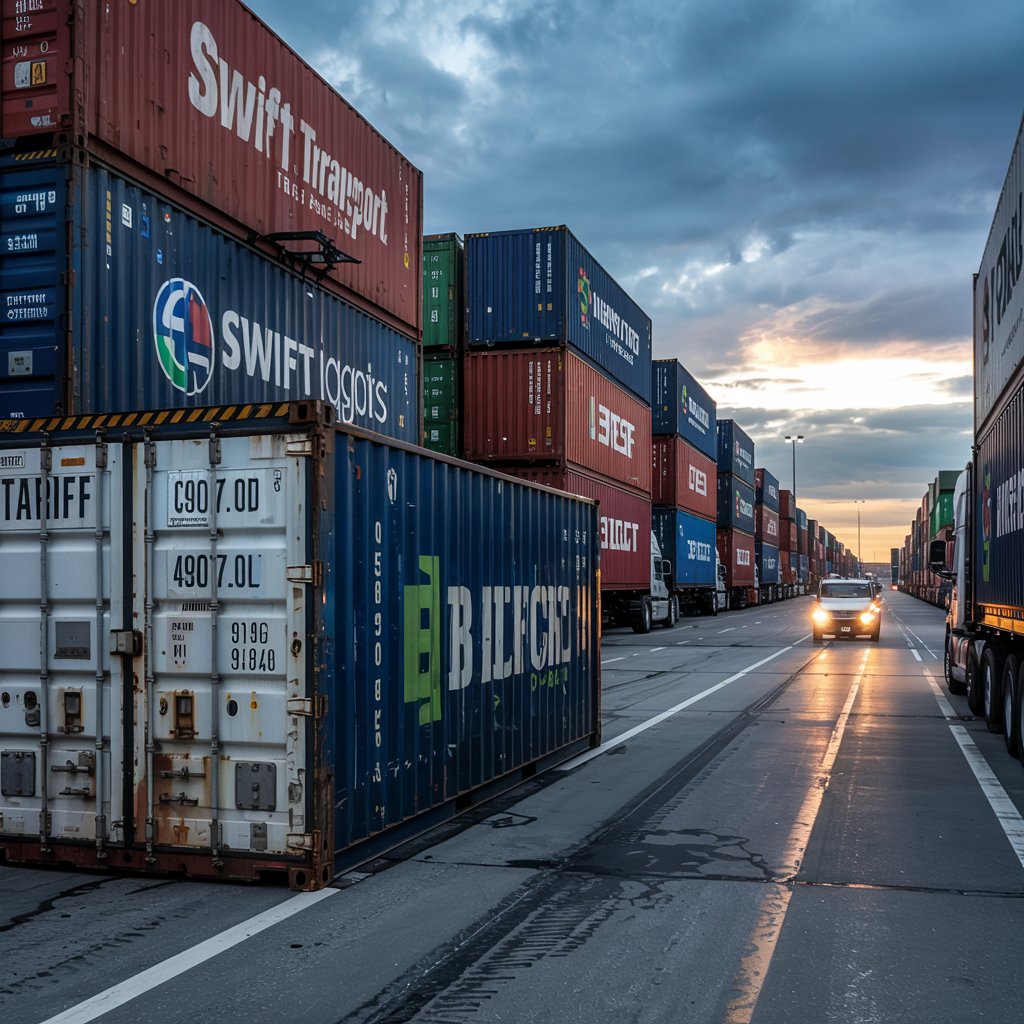Tariffs and trucking have reshaped the landscape in significant ways. As costs rise for imported goods, shipping rates follow suit, putting pressure on freight companies. You’re likely wondering how these changes affect operational strategies and overall supply chain dynamics. The challenges are many, but so are the opportunities for adaptation. What does this mean for the future of the U.S. freight sector? Let’s explore the complexities that lie ahead.
Key Takeaways
- Tariffs increase costs for imported goods, leading to higher shipping rates that impact the trucking industry’s operational expenses.
- Supply chain disruptions from tariffs force trucking companies to adjust routes and sourcing strategies, affecting freight volume and availability.
- Increased competition among freight carriers arises from limited loads, resulting in price fluctuations and strained profit margins.
- Compliance with new regulations and rising operational costs necessitate additional investments, potentially impacting trucking companies’ financial stability.
- Adoption of technology and real-time tracking can help trucking companies optimize operations and adapt to changes caused by tariffs.
Introduction to New Tariffs and Trucking in the U.S. Freight Sector
New tariffs have recently reshaped the landscape of the U.S. freight sector, impacting everything from shipping costs to delivery times.
You might be wondering how these changes have affected trucking companies and their operations.
Initial reactions from the industry reveal a mix of concern and adaptation as businesses navigate this evolving environment.
Overview of Recent Tariff and trucking Implementations
As the landscape of international trade evolves, recent tariff implementations have markedly impacted the U.S. freight sector. You might wonder how these changes affect freight companies and their financial stability. Here’s a quick overview of what’s been happening:
- Increased costs for imported goods
- Adjustments in shipping rates to cover tariff expenses
- Supply chain disruptions leading to delays
- A shift in trade routes to avoid tariffs
- Heightened competition among freight carriers
These recent U.S. tariffs have forced freight companies to adapt quickly, weighing their financial impact against the need to maintain service quality.
Understanding these dynamics will help you navigate the challenges and opportunities that arise in this ever-changing environment.
Initial Reactions from the Freight Industry
The freight industry has quickly responded to the recent tariff implementations, with reactions ranging from concern to strategic adjustment.
Many of you’re feeling the pressure of tariff-induced costs, which are squeezing margins and complicating logistics. Overland freight issues are becoming more pronounced as carriers navigate the rising expenses and shifting trade dynamics.
You’re not alone in your worries; industry leaders are actively discussing solutions and sharing best practices to mitigate these challenges. By collaborating and exchanging insights, you can adapt to this evolving environment more effectively.
Embracing innovative strategies not only helps you stay competitive but also fosters a sense of community within the industry. Together, you can turn these obstacles into opportunities for growth and resilience.
Immediate Effects on Freight Volume and Bookings
As tariffs come into play, you might notice a sharp decline in ocean container bookings, affecting supply chains markedly.
This disruption doesn’t stop at the ports; it also ripples through domestic freight movements, causing delays and increased costs.
Understanding these immediate effects is essential for traversing the current landscape of the trucking industry.
Decrease in Ocean Container Bookings
Recent declines in ocean container bookings have created a ripple effect on freight volume and overall bookings in the trucking industry.
As shipping demand reduces, you might notice several immediate impacts:
- Freight volumes decreasing considerably
- Container bookings dropping across various sectors
- Increased competition among trucking companies for limited loads
- Price fluctuations in transportation costs
- Potential delays in deliveries as logistics adjust
These changes can make it challenging to maintain a steady flow of business.
You’re not alone in maneuvering through these turbulent times; many in the industry are feeling the squeeze.
By staying informed and adapting to these trends, you can better position yourself in this evolving landscape.
Together, let’s find ways to overcome these hurdles and strengthen our connections in the trucking community.
Impact on Domestic Freight Movements
While declining ocean container bookings affect global shipping, they also considerably impact domestic freight movements.
As you navigate the trucking industry, you might notice immediate effects on freight volume and bookings due to the upcoming tariff changes in 2025. These changes can create uncertainty, making it harder for you to plan and secure shipments.
With trucking industry tariffs rising, shippers may hesitate to book loads, leading to decreased availability. This ripple effect can leave you feeling unsettled, as demand fluctuates and prices rise.
Financial Implications for Freight Companies

As tariffs rise, you’ll notice increased operational costs impacting your bottom line.
This surge can lead to revenue losses and squeeze your profit margins, forcing you to reassess pricing strategies.
It’s essential to understand how these financial implications could affect your business in the long run.
Increased Operational Costs
The rising tariffs have greatly impacted operational costs for freight companies, leading to tighter profit margins. You might feel the pinch as these costs increase, driven by various factors.
Here’s what you should consider:
- Fuel prices continue to soar.
- Maintenance expenses for aging fleets are climbing.
- Compliance with freight regulations requires additional investment.
- Labor costs are on the rise, affecting hiring budgets.
- Insurance premiums have become markedly higher.
As operational costs rise, it’s essential to adapt your strategies. Embracing efficiency and exploring cost-saving measures can help you stay competitive in this challenging landscape.
Revenue Losses and Profit Margins
| Factor | Impact on Revenue Losses |
|---|---|
| Increased Tariffs | Higher transportation costs |
| Operational Costs | Reduced efficiency |
| Fuel Prices | Eroded profit margins |
Revenue losses have become a pressing concern for freight companies grappling with rising tariffs and operational costs. These financial strains directly impact your profit margins, making it essential to adapt and strategize effectively.
To thrive in this challenging environment, you need to closely monitor your expenses and find innovative ways to optimize your operations. Collaborating with industry partners can also provide the support you need to mitigate these losses. By staying proactive and connected with others in the industry, you can navigate these turbulent waters together and work toward improving your bottom line.
Shifts in Supply Chain Dynamics
As tariffs impact costs, you’ll need to contemplate rerouting shipments and sourcing materials from different suppliers.
These changes can complicate your inventory management, leading to potential stock shortages or excess.
Adapting quickly is key to maintaining efficiency in your operations.
Rerouting and Alternative Sourcing
While tariffs have reshaped the landscape of global trade, businesses are increasingly focusing on rerouting and alternative sourcing to adapt to these changes.
You’re not alone in this; many companies are exploring new paths to guarantee smooth operations.
Here are some effective approaches you might consider:
- Diversifying your sourcing strategy changes to reduce dependency on a single region.
- Identifying alternative supplier strategies that align with your quality and budget needs.
- Collaborating with local suppliers to minimize shipping costs and time.
- Leveraging technology for real-time supply chain visibility.
- Engaging in partnerships to share resources and expertise.
Inventory Management Challenges
Rerouting and alternative sourcing strategies can help mitigate some of the impacts of tariffs, but they also bring new inventory management challenges. You might find yourself juggling fluctuating lead times and increased costs, causing uncertainty in your stock levels.
As the freight sector forecast shifts, staying connected with your suppliers becomes essential. You’ll want to guarantee that communication is open and transparent to navigate these challenges together.
Keeping a close eye on demand patterns will help you adapt quickly, preventing stockouts or overstock situations. Building a strong network with other businesses facing similar hurdles can foster a sense of belonging and support, allowing you to tackle these inventory management challenges more effectively.
Embrace collaboration as you adapt to this evolving landscape.
Impact on Specific Freight Modes

Now that you understand the shifts in supply chain dynamics, let’s explore the impact on specific freight modes.
The trucking industry is facing unique challenges, while rail and air freight are adjusting to new demands.
These changes can greatly affect your logistics strategy, so it’s vital to stay informed.
Trucking Industry Challenges
As the trucking industry grapples with various challenges, the impact on specific freight modes becomes increasingly apparent. You might notice how current freight industry trends are shaping your operations.
Here are some key challenges you should be aware of:
- Rising fuel prices affecting overall costs
- Shortage of qualified drivers, stressing logistics
- Regulatory changes complicating compliance
- Increased competition pushing for operational cost reduction
- Technology adoption, requiring investment and training
These challenges aren’t just numbers; they impact your daily operations and profitability.
Rail and Air Freight Adjustments
While the trucking industry faces its own set of challenges, rail and air freight are adapting to their unique pressures as well. Each mode is feeling the mode-specific tariff impact differently, shaping how companies approach logistics.
Rail freight, for instance, often thrives on bulk shipments, so it’s adjusting routes and schedules to minimize regional freight impact.
Meanwhile, air freight is tackling higher costs and tighter timelines, leading to innovative solutions like cargo consolidation.
As you navigate your options, it’s essential to recognize how these adjustments can affect your supply chain. By understanding these dynamics, you can make informed decisions that foster a sense of community and collaboration within the industry.
Together, we can adapt and thrive in this evolving landscape.
Regional Effects Across the U.S
When you think about tariffs, consider how they impact different regions of the U.S.
Port cities and coastal areas often feel the immediate effects due to their reliance on international trade.
Meanwhile, inland transportation hubs face unique challenges as they adapt to shifting supply chains and freight demands.
Port Cities and Coastal Regions
Port cities and coastal regions play an essential role in the U.S. economy, acting as gateways for international trade.
However, recent tariffs have impacted these areas considerably, leading to a freight volume decline and various geographic tariff effects.
You may not realize how interconnected your community is with global markets, but here’s what you should know:
- Increased costs for imported goods
- Reduced shipping traffic at major ports
- Strain on local trucking businesses
- Job losses in logistics and shipping industries
- Potential rise in consumer prices
Understanding these effects can help you navigate the changing landscape of trade and support your local economy.
Together, we can adapt to these challenges and find new opportunities for growth.
Inland Transportation Hubs
Inland transportation hubs are essential for distributing goods across the U.S., especially as tariffs reshape trade dynamics. These hubs facilitate supply chain shifts, allowing you to connect with markets more efficiently. As freight technology adoption increases, you’ll notice improvements in tracking and logistics, enhancing your operational capabilities.
| Hub Location | Impact on Supply Chain |
|---|---|
| Chicago, IL | Central distribution point |
| Memphis, TN | Major air freight center |
| Kansas City, MO | Rail and highway networks |
| Dallas, TX | Cross-border trade access |
Responses from Trade Partners and Global Markets
As tariffs rise, you’re likely to see trade partners respond with retaliatory measures, sparking potential trade wars.
These tensions can shift global shipping routes, affecting how goods move across borders.
It’s essential to understand how these changes impact your industry and the broader market.
Retaliatory Tariffs and Trade Wars
While trade disputes often begin with one country imposing tariffs, they quickly escalate as affected nations retaliate, leading to a cycle of trade wars.
You might wonder how these retaliatory tariffs impact the global market and your everyday life. Here are some key points to take into account:
- Increased Product Costs: Prices for goods can rise due to higher tariffs.
- Supply Chain Disruptions: Businesses may face delays and increased shipping costs.
- Consumer Choices Limiting: You might find fewer options as imports decline.
- Economic Uncertainty: Market volatility can affect your investments and job security.
- Long-term Relationships Strained: Trust between trading partners can diminish, complicating future negotiations.
It’s essential to stay informed and understand how these escalating trade tensions can affect you and your community.
Shifts in Global Shipping Routes
With trade tensions rising, countries are rethinking their shipping routes to adapt to new tariffs and regulations. This shift leads to significant supply chain rerouting, as businesses seek more efficient paths to maintain competitiveness. You might notice how international trade responses vary across regions, affecting your local markets and shipping costs.
| Region | New Routes | Impact on Trade |
|---|---|---|
| North America | Shift to East Asian ports | Increased shipping times |
| Europe | Direct routes to South Asia | Lower tariffs |
| South America | Trade with Africa | Expanded market access |
These changes not only influence global commerce but also shape your everyday choices as consumers. Staying informed about these dynamics helps you understand the bigger picture.
Regulatory and Policy Considerations
When you think about regulatory and policy considerations in trucking, government aid and subsidies often come to mind.
These financial supports can greatly impact your business operations and competitiveness.
Additionally, you should consider the long-term policy implications that may shape the industry’s future.
Government Aid and Subsidies
As the trucking industry grapples with the impacts of tariffs, government aid and subsidies become essential in mitigating financial strain.
By leveraging effective government support measures, you can help sustain your operations and guarantee stability in your business. Here are some key aspects to reflect on:
- Access to freight industry subsidies can reduce operational costs.
- Temporary relief programs can ease cash flow issues.
- Grants for fuel-efficient technologies can lower long-term expenses.
- Training programs can enhance workforce skills and productivity.
- Tax incentives can encourage investment in infrastructure.
These support mechanisms not only foster resilience but also create a sense of community among trucking professionals.
Long-Term Policy Implications
While the immediate effects of tariffs on the trucking industry are often discussed, the long-term policy implications deserve equal attention. You should consider how future trade policies and regulatory changes forecast could shape the landscape of trucking. Understanding these changes is vital for your business strategy.
| Policy Area | Impact on Trucking |
|---|---|
| Tariffs on Imports | Increased shipping costs |
| Environmental Regulations | Need for greener fleets |
| Infrastructure Funding | Improved road conditions |
| Labor Regulations | Workforce availability issues |
| Technology Adoption | Enhanced efficiency potential |
Technological and Operational Adaptations
As tariffs reshape the trucking industry, you’re likely considering how automation and efficiency measures can help your operations.
Investing in domestic manufacturing might also be a smart move to stay competitive.
Let’s explore how these technological and operational adaptations can position you for success.
Automation and Efficiency Measures
To thrive in the competitive trucking industry, companies are increasingly turning to automation and efficiency measures that streamline operations and reduce costs. By embracing these innovations, you can enhance operational efficiency and stay ahead in the game.
Consider these key strategies:
- **Implement *freight automation*** to optimize routing and scheduling.
- **Use *telematics*** for *real-time data* on vehicle performance.
- **Adopt *advanced software solutions*** for inventory and supply chain management.
- **Invest in *training for your team*** to guarantee smooth integration of new technologies.
- **Leverage *AI and machine learning*** to predict demand and adjust logistics accordingly.
These steps not only improve your bottom line but also foster a sense of community among your team, making everyone feel valued and engaged in the process.
Investment in Domestic Manufacturing
Investing in domestic manufacturing can markedly enhance your trucking operations by reducing reliance on foreign supply chains and mitigating the impact of tariffs.
By embracing domestic manufacturing investment, you’re not just supporting your business; you’re also strengthening your community. Reshoring initiatives allow you to tap into local resources and talent, fostering a sense of belonging and collaboration.
Plus, you’ll benefit from shorter lead times and improved quality control. When you support local manufacturing, you’re creating jobs, driving innovation, and building a resilient supply chain that can adapt to changing market conditions.
This strategic shift not only enhances your operational efficiency but also positions your business as a leader in the trucking industry, paving the way for sustainable growth and community support.
Future Outlook for the U.S. Freight Sector
As you look ahead, it’s clear that the U.S. freight sector is set to face significant changes.
You’ll want to pay attention to predicted industry trends and how companies adapt with strategies for resilience and growth.
Understanding these developments will be vital for maneuvering the evolving landscape.
Predicted Industry Trends
While the freight sector faces ongoing challenges, including fluctuating tariffs and supply chain disruptions, its future outlook remains promising.
You’ll notice several key trends shaping the industry:
- Increased adoption of technology for efficiency
- Growth in e-commerce driving demand for trucking
- Shift towards sustainable practices and electric vehicles
- Enhanced workforce training to address labor shortages
- Collaboration between companies to mitigate new tariffs impact
These trends indicate that despite the trucking and shipping effects from new tariffs, the industry is adapting and evolving.
By staying informed and engaged, you can navigate these changes and seize opportunities for growth in a dynamic landscape.
Embrace the future knowing that the freight sector is resilient and ready for what’s next!
Strategies for Resilience and Growth
The trucking industry isn’t just facing challenges; it’s actively seeking ways to thrive amidst them. By adopting future logistics strategies, you can guarantee your business adapts to ever-changing demands.
Emphasizing resilience planning helps you build a robust framework that can withstand economic fluctuations and supply chain disruptions. Collaborating with partners who share your commitment to innovation fosters a sense of community and belonging, making it easier to navigate these challenges together.
Investing in technology solutions like real-time tracking and data analytics can enhance efficiency and strengthen customer relationships. As you embrace these strategies, you’ll not only survive but also position your company for growth and success in the evolving freight landscape.
Together, you can face the future with confidence.
Frequently Asked Questions
How Do Tariffs Affect Shipping Rates for Small Businesses?
When costs rise, you might notice shipping rates climbing too. These increases can squeeze your budget, making it tougher to compete. Staying informed and adjusting your strategies can help you navigate these challenges effectively.
Are There Specific Industries More Affected by Tariffs Than Others?
Absolutely, some industries face greater impacts from tariffs, like manufacturing and agriculture. You’ll notice increased costs affecting their pricing and competitiveness. Staying informed helps you navigate these challenges and make better decisions for your business.
What Are the Long-Term Implications of Tariffs on Trucking Employment?
You’ll find that long-term implications often lead to job shifts and uncertainty in trucking. As industries adapt, you may notice changes in demand, affecting your job security and opportunities for growth in the sector.
How Can Trucking Companies Mitigate Tariff-Related Costs?
To mitigate costs, you can streamline operations, negotiate better contracts, and invest in technology. Collaborating with suppliers and optimizing routes will also help you stay competitive while maintaining strong relationships within your network.
Do Tariffs Influence the Choice of Freight Transportation Modes?
When you consider freight transportation modes, you’ll find tariffs play a significant role. They can shift your choices toward cost-effective options, ensuring you stay competitive while fostering connections within your network and community of businesses.
Final Thoughts
So, as tariffs tighten their grip on the trucking industry, you might imagine freight companies donning superhero capes, battling rising costs and chaotic supply chains. They’re not just hauling goods; they’re juggling flaming torches while riding unicycles through a storm. If they don’t adapt, it’s like trying to drive a truck on a tightrope—one wrong move, and it’s a crash landing back to square one. In this circus, innovation and collaboration are the only safety nets they’ve got.










